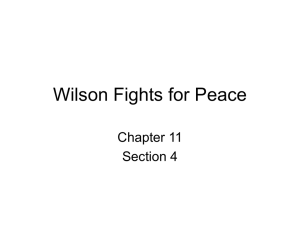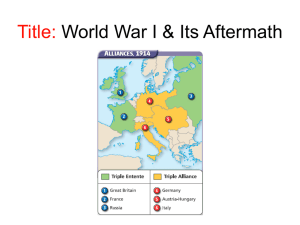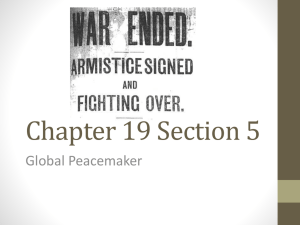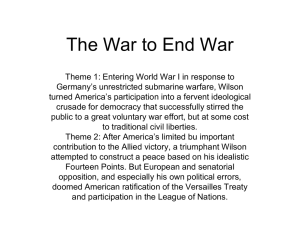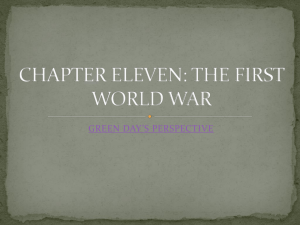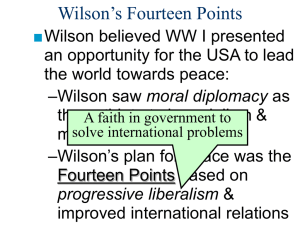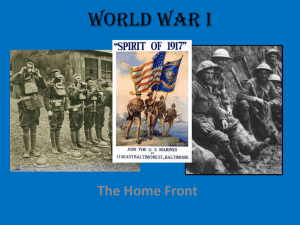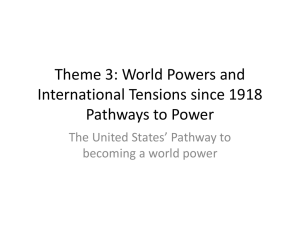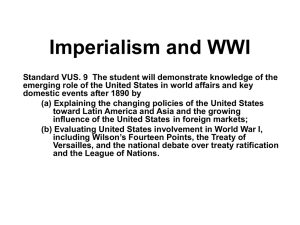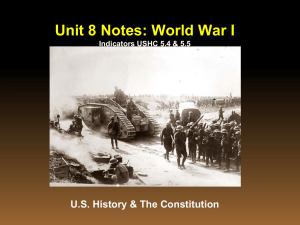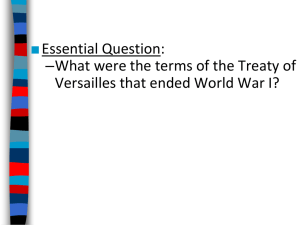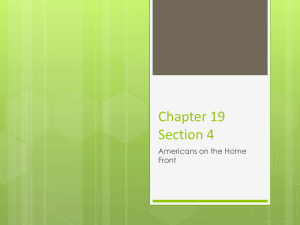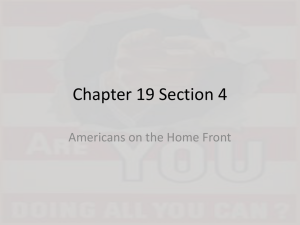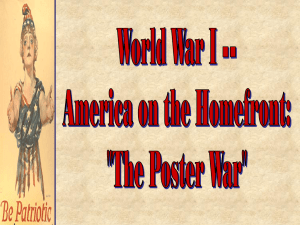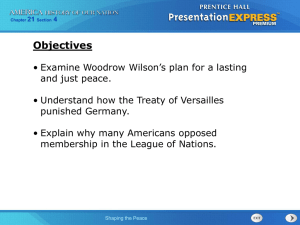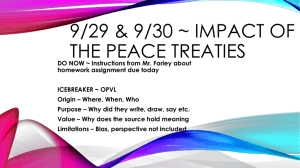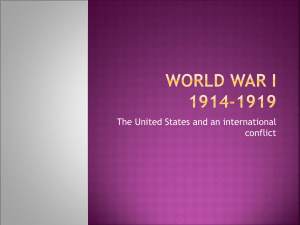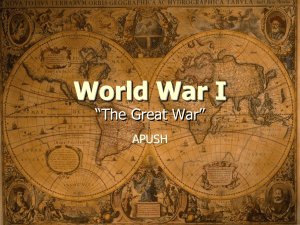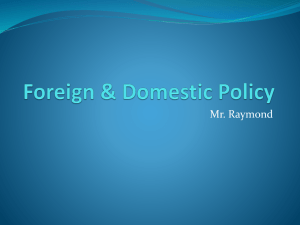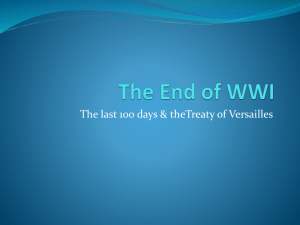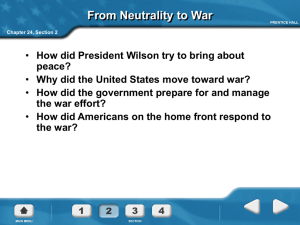U.S._History_Ch_8_Section_3
advertisement
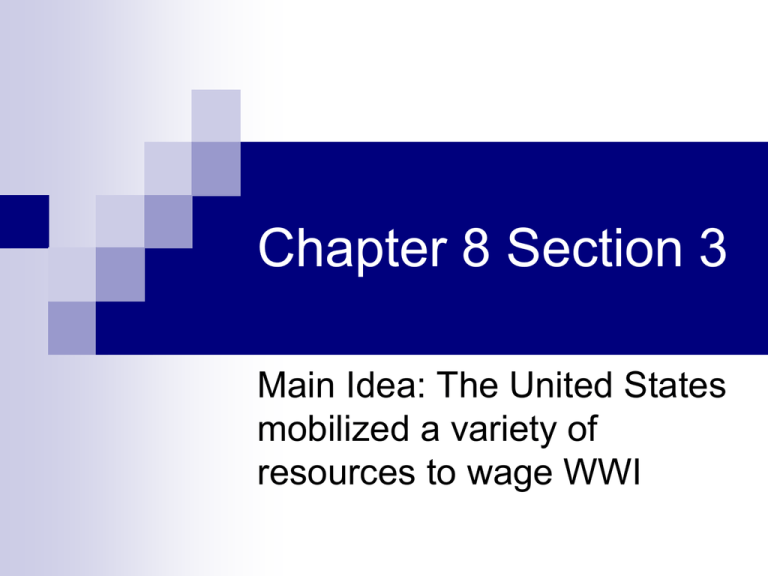
Chapter 8 Section 3 Main Idea: The United States mobilized a variety of resources to wage WWI Learning Objectives for Section 3 Identify how the government mobilized the economy for the war effort Learn how workers mobilized on the home front Recognize how the government tried to influence public opinion about the war Bellringer/ Section Preview What was a Liberty Bond? When the U.S. entered the war in 1917, President Wilson called on everyone to join the war effort. To help pay for the war, he launched 4 drives to sell Liberty bonds. The bonds (like today’s savings bonds) were a form of loan to the government. Campaigns to sell the bonds were intense. Celebrities from movie stars to baseball players to opera singers appeared at bond rallies. Artists and advertising experts produced slogans and colorful posters. They appealed to patriotism, fear, or sympathy for war victims in Europe to urge people to buy bonds. In all, the bond drives brought in almost $17 billion Review Questions What were Liberty Bonds? Describe some of the campaigns that were used to help sell Liberty Bonds? Mobilizing the Economy Going to war was an expensive undertaking In 1917 Congress passed the War Revenue Act which established high taxes especially for the rich. This increased federal revenues by 400% within 2 years Government also borrow money, increasing national debt from $1.2 billion to $25.5 billion within 3 years, most in the form of Liberty bonds Regulating Industry Jobs were created to regulate industry and agricultural production and distribution WIB (War Industries Board) headed by Bernard Baruch regulated all materials needed for the war effort All goods were used by military first, then leftovers were for civilians Regulating Food Congress passed the Lever Food and Fuel Control Act Gave the government the power to set prices and control the production of food and fuels needed for the military Herbert Hoover (future President) was appointed head of Food Administration, whose goal was to increase food production, and conserve food supplies Hoover asked farmers to increase food production, Asked civilians to plant victory gardens, participate in meatless Mondays, and wheatless Wednesdays Resulted in a surplus of food Also started a prohibition on alcohol (because it is made from grapes or wheat) Eighteenth Amendment was ratified banning the manufacture, sale, or transportation of alcohol in the U.S. Regulating Fuel Fuel Administration was established to set production goals and prices for fuels It introduced daylight savings time, to increase daylight hours for those who worked long shifts in factories. Promoted gasless Sundays and heatless Mondays Reading Focus Question #1 How did the government mobilize the economy for the war effort? Raised taxes, borrowed money through war bonds, regulated industry, food, and fuel in order to supply troops Supplying U.S. and Allied troops Creating boards and agencies helped the U.S. produce and collect the supplied it needed for the war Also supplied Allied troops besides American troops Provided a boost for Allied powers and boost to U.S. economy Mobilizing Workers During the war, wages for workers increased, however the cost of food and housing went up as well Laborers were working longer hours to increase production Workers began joining unions and more than 6,000 strikes were held during the war National War Labor Board Wilson creates the National War Labor Board in 1918 to judge disputes between workers and management Also set policies to improve working conditions such as 8 hour work day, equal pay for women, Women’s war efforts As men left for war, women moved into their production jobs Worked in factories, at docks, and on railroads Also worked as teachers and nurses Some volunteered to sell liberty bonds or dig victory gardens Reading Focus Question #2 How did workers mobilize on the home front? Laborers worked long hours to produce war materials. Women moved into jobs vacated by men who were sent to the front Influenza Epidemic on the Home Front 50% of American loss of life resulted from a serious flu epidemic Back in the U.S. an army private complained of flu like symptoms. By the end of the week more than 500 soldiers had the flu. This was a deadly flu. In one month more than 200,000 Americans died Public events were cancelled Germans were blamed for spreading the flu Influencing Public Opinion Wilson created the Committee on Public Information (CPI) headed by George Creel Started a nationwide campaign of propagandanewspapers stories, posters, speeches and other materials used to influence public opinion Americans not only supported the war, also began to distrust everything German Opened up discrimination to German Americans Reading Focus Question #3 How did the Government try to influence public opinion about the war? It created the Committee on Public Information to oversee a nationwide campaign of propoganda Limiting Anti-War speech Some Americans, such as Jane Adams, spoke out against the war Wilson tried to limit anti-war speech In 1917, Congress passed the Espionage Act which punished people for aiding the enemy or refusing military duty Next year it passed the Sedition Act which made it illegal to utter, print, or publish any disloyal or abusive language criticizing the government, military, or the flag Resulted in more than 1000 people being jailed Some believed the Sedition Act violated the 1st Amendment Others believed the Sedition Act was needed to protect military secrets and for the safety of soldiers Charles Schenck was a socialist who published 15,000 pamphlets criticizing the war. He was jailed. He challenged his conviction as a violation of his Right to Free Speech. Supreme court upheld his conviction. Review Questions for Section #3 What was the War Revenue Act of 1917? What was the function of the War Industries Board? What steps did the fuel administration take to encourage fuel conservation? What were some policies set by the National War Labor Board? How did war demands lead to an increase in in union membership? How did the infulenza epidemic affect American life? What is propaganda? Section 4: Peace without Victory Main Idea: The Allies determined the terms for peace in the post-war world Learing Objectives for Section 4 Identify President’s Wilson’s Fourteen Points plan for peace Learn what was resolved at the Paris Peace Conference Realize why Congress fought over the treaty Describe the Impact of World War I on the United Stated and the World Bell Ringer /Preview Section 4 Will the treaty pass? President Wilson had to make compromises in writing the Treaty of Versailles after World War I. The treaty did however, include his greatest dream, a League of Nations that would work to ensure peace. Although he was exhausted, Wilson decided to go to the American people to win support for Senate approval of the treaty. In 3 weeks, he traveled from city to city, speaking several times a day. On Sept. 25th 1919, Wilson collapsed after speaking. After returning to Washington, he suffered a stroke. He refused to compromise on changes and the treaty was defeated. The U.S. never joined the League of Nations. Review Questions What part of the Treaty of Versailles was most important to Woodrow Wilson? What was the purpose of the trip that preceded Wilson’s stroke? The Fourteen Points First 4 points called for open diplomacy, freedom, freedom of the seas, removal of trade barriers, and reduction of military arms 5th point called for proposed a fair system to resolve disputes over colonies 8-13 dealt with self-determination- or the right of people to decide their own political status 14th point called for establishment of a League of Nations- an organization of Nations that would work together to solve disputes, protect democracy, and prevent war Reading Focus Question #1 What was President Wilsons Fourteen point plan for peace? A plan that applied the principles of progressivism to foreign policy to help ensure that another war like the Great War would never happen again Paris Peace Conference President Wilson was the 1st President to visit Europe Led the American negotiators to the Paris Peace Conference Began on Jan 12, 1919 32 nations attended Leaders of U.S. Britain, France, and Italy became known as the Big 4. Central Powers were not invited to attend Conflicting needs Wilson had a vision of a better world Other nations wanted to punish Germany Some nations wanted their independence Some wanted to build new nations Outcomes of the Treaty of Versailles: forcing Germany must disarm, Germany to pay reparations, Germany had to accept sole responsibility for starting the war, establishment of League of Nations, Right to self-determination for Germany, Russia, and Austria-Hungary Creation of 9 new nations including Czechoslovakia, Poland,& Yugoslavia Germany strongly opposed the conditions but signed anyway Reading Focus Question #2 What was resolved at the Paris Peace Conference? Germany had to disarm, pay reparations, take blame, and League of Nations was established The Fight over the Treaty When president Wilson returned to the U.S. he presented the treaty to Congress Congress was split into 3 groups Demcrats who wanted to ratify it Irreconcilibles who refused it Reservationists who would ratify it only if changes were made Wilson refused to compromise the treaty and instead went to the American people. Made 32 speeches in 22 days urging public support for the treaty He suffered a stroke and spent the rest of his term living in the White House cut off from the public After Wilson left office in 1921, the U.S. entered into separate peace treat with Austria, Germany and Hungary The Impact of World War I 14 million deaths 7 million permanently disabled people Resulted in overthrow of monarchies in Russia, AustriaHungary, Germany, and the Ottoman Empire Devastated European economies U.S. emerged as the world’s leading economic power Led women into the workforce Women granted the right to vote Period of rapid inflation in the United States Reading Focus Question #3 What was the impact of WW I on the United States and the world? It left millions of people dead; cost billions of dollars; monarchies were overthrown; European economies were devastated; Review Questions Section 4 What was President Wilson’s purpose for going to Europe? Who were the Big Four? How was Congress divided over the Treaty of Versailles? What casualties resulted from World War I? How did World War I have a lasting effect on American society? CST Practice Question During World War I, the U.S. Supreme Court issued a ruling in Schenck vs. United States that Expanded civil liberties b. Upheld limits to free speech c. Overturned limits to free speech d. Made it illegal to refuse military duty a. Answer During World War I, the U.S. Supreme Court issued a ruling in Schenck vs. United States that a. Expanded civil liberties b. Upheld limits to free speech c. Overturned limits to free speech d. Made it illegal to refuse military duty CST Practice Question To conserve food during World War II, the U.S. government Introduced daylight savings time b. Encouraged Americans to buy war bonds c. Limit the alcohol content of wine and beer d. Encouraged Americans to plant victory gardens a. Answer To conserve food during World War II, the U.S. government a. Introduced daylight savings time b. Encouraged Americans to buy war bonds c. Limit the alcohol content of wine and beer d. Encouraged Americans to plant victory gardens
